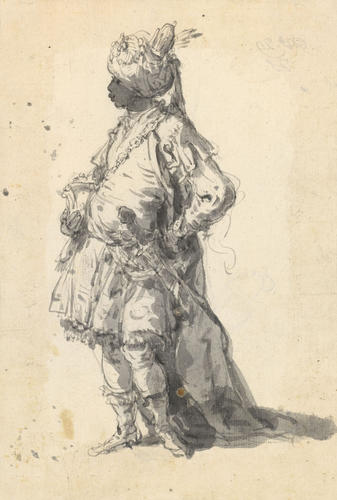-
1 of 253523 objects
A study for the Black king c. 1726
Pen and ink and wash | 19.9 x 13.4 cm (sheet of paper) | RCIN 907091

Sebastiano Ricci (Belluno 1659-Venice 1734)
A study for the Black king c. 1726
-
A pen and ink and wash drawing of a standing king in a turban, one arm on his waist, the other holding a casket of frankincense. Inscribed on the verso: No. 29 JS. A study for the Black king on the right in Ricci's painting The Adoration of the Magi (RCIN 405743), one of seven paintings of the New Testament painted for Smith by Ricci. The drawing is one of 16 drawings relating to the painting in the Windsor album. Another study for the same king is 907089.
The idea of depicting one of the three Magi as Black developed in the medieval period, when each of the Three Kings was used to represent the three continents of Christendom: Europe, Asia and Africa. This became a common trope in European art, and was often combined with a tendency to show Black sitters as a kind of fantasy, dressed in luxurious silks and turbans, as seen in the tronies of seventeenth century Dutch art. In Sebastiano Ricci's painting, Balthasar is the most prominent of the Three Kings, standing on the right of the composition, directly counterbalancing the figure of the Virgin. This drawing shows an alternative view from the front, with Balthasar holding his gift of frankincense in the crook of his arm, with much attention paid to his silk tunic, cloak and turban. The drawing 907089 is closer to the final pose of the King in the painting, seen in three-quarters from behind and with his face in profile, focussing attention on his robes, his voluminous sleeve, and his sword. In the painting he is also accompanied by a Black attendant.Provenance
Consul Joseph Smith; acquired by George III in 1762
-
Medium and techniques
Pen and ink and wash
Measurements
19.9 x 13.4 cm (sheet of paper)